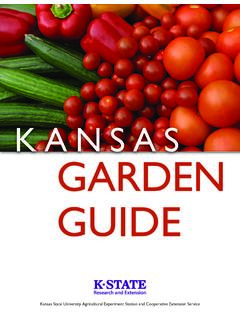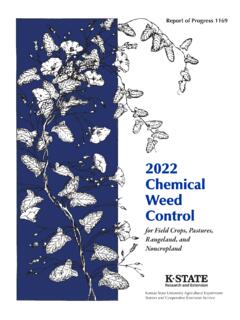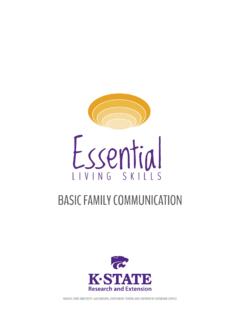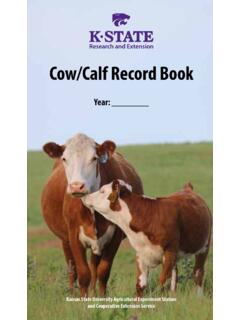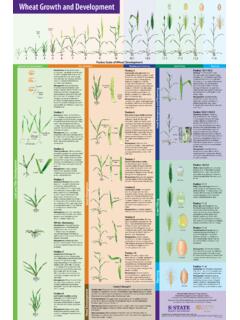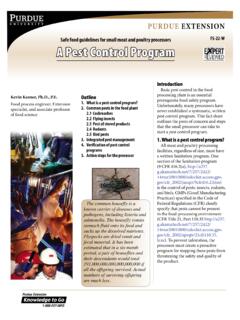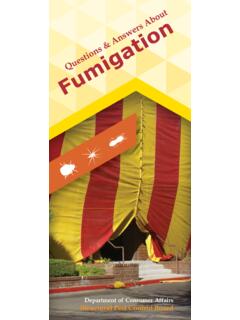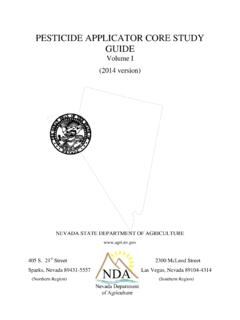Transcription of S12 General Manual: Pesticide Application Training
1 GeneralManualKansas State University Agricultural Experiment Station and Cooperative Extension ServicePESTICIDE Application TRAINING2 Table of ContentsCertification Procedures 3 Pests and Pest control 5 Pest control Methods Insects Plant Disease Agents Weeds Mollusks Wildlife Damage control Pesticide Formulations 29 Types of Formulations Adjuvants CompatibilityLabels and Labeling 36 Parts of the Label Label Terminology Reading the LabelProtecting the Environment 59 Potential Hazards Potential BenefitsApplication Equipment 66 Sprayers Nozzles Tips Dusters and Granular ApplicatorsCalibration 75 Laws and Regulations 85 FIFRA Registration Residues and Tolerances Other Regulations Pesticide Safety 93 Protecting Your Body Handling pesticides Safely First Aid and Pesticide Poisoning RecognitionOther Terms Used in Pest control 110 Directions for Using this ManualThis is a self-teaching manual.
2 At the end of each major section is a list of study questions to check your understanding of the subject matter. By each question in parenthesis is the page number on which the answer to that question can be found. This will help you in checking your study questions are representative of the type which are on the certification examination. By reading this manual and answering the study questions, you should be able to gain sufficient knowledge to pass the Kansas Commercial Pesti-cide Applicators Certification and Recertification ornamental shrubbery or turf pests on property owned or rented by the individual and such property is used as the individual s certification may not be necessary if restricted use pesticides are used: a.
3 Within the authority granted by a private applicator certifica-tion b. under the supervision of a certified commercial applicator. (This does not apply to aerial applicators or where supervision is prohibited by label direction or other legal authority.) c. by veterinarians or physi-cians, as part of their professional services d. by laboratory personnel in pest icide researchIn order to qualify for certification you must: a. be at least 18 years old, b. submit a completed applica-tion for certification, c. pass the General Exam (cov ered by this manual) plus an exam in at least one category/subcategory of Application , d.
4 Pay the required fees. There is a separate Application fee and exam fee. Applicants who fail a specific category exam may take another exam upon paying an additional exam fee. No fee is required to take the General Exam. Upon meeting the qualifications for certification, a certificate and a pocket card will be issued by the Kansas Department of Agriculture. Your cer-tification will expire on December 31 of the second calendar year following the year it was issued. For example, if you are issued your certificate on June 1, 1995, it will expire on December 31, can be obtained by either of two options: 1.
5 Passing an examination over the General manual and your specific category manual, similar to your initial certification, or 2. Attending a Pesticide appli-Certification ProcedureThis manual has been written to assist those persons who are prepar-ing themselves for an examination over the General Standards portion of the commercial Pesticide applicator certification exam. State and Fed-eral regulations specify that certain standards of competency relating to both General and specific topics must be met by an individual before they are allowed to apply or supervise the Application of Restricted Use Pesti-cides.
6 The General Standards portion of the examination must be success-fully completed by all categories of applicators. Therefore, this manual may contain information over top-ics that do not directly relate to your specific categories or types of applica-tion law a Pesticide is defined as follows: Pesticide means, but is not limited to, (1) any substance or mixture of substances used to pre-vent, destroy, control , repel, attract or mitigate any pest (including weeds) and (2) any substance or mixture of substances intended to be used as a plant regulator, defoliant or are classified by the EPA as either Restricted Use or General Use (not restricted).
7 A certified ap-plicator is required when a restricted use Pesticide is being used. Under the Kansas Pesticide Law, a certified commercial applicator means a certi-fied applicator, whether or not he/she is a private applicator with respect to some uses, who uses or supervises the use of any Pesticide which is classi-fied for restricted use for any purpose or on any property other than that provided for in the definition of cer-tified private applicator. A certified private applicator is one who uses or supervises restricted use pesticides for purposes of: (a) Producing any ag-ricultural commodity, (1) on property owned or rented by the individual or such individual s employer, or (2) on the property of another for no com-pensation than trading of personal services between producers; or (b) 4cator Training meeting approved by the secretary (no examination required).
8 In order to qualify for recertifica-tion, you must submit a new applica-tion and pay the applicable fees. Note that if the required Training is not attended during your effective period of certification, then to be certified again you must retake and pass a current examination. Certification in another state does not replace the requirement for an applicator to have Kansas commercial applicator certification. Kansas has entered into reciprocal agreements with a few states, whereby commer-cial certification in any of those states may be used in lieu of passing Kansas commercial certification exams.
9 However, the applicator is required to complete the other requirements for Kansas certification, including submitting an Application and paying fees. Further details on reciprocal cer-tification are available from the Plant Health Division of the Kansas Depart-ment of LicenseA Kansas Pesticide Business License is required before any com-mercial pest control efforts, including advertising, are attempted. Obtaining this business license has different pro-cedures and requirements from those for becoming a certified commercial Pesticide applicator. In brief, there are four requirements to obtain the busi-ness license: 1.
10 Complete the Application ; 2. pay the fee (calendar year basis); 3. furnish proof of financial responsibility; and 4. have at least one person certi-fied in the categories/subcatego-ries of information on the Kansas Pesticide Business License can be found in the chapter on Laws and Regulations in this manual. Also, for an informational packet, write the Kansas Department of Agriculture, Plant Health Division, Certification Record Center, 901 So. Kansas Ave., Topeka, KS 66612 1280, or phone 785 pest is anything that: competes with humans, domes-tic animals, or crops for food, feed, or water, injures humans, animals, crops, structures, or possessions, spreads disease to humans, domestic animals, or crops, annoys humans or domestic animals.
